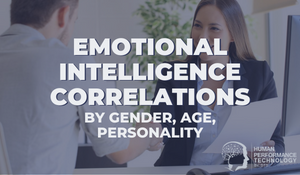In a Nutshell: Emotional Intelligence (Goleman Model)
Emotional intelligence (EI or EQ) is now firmly established in business as a term that, for many professionals, replaces “people skills” and “soft skills.” EI came into the public spotlight when Daniel Goleman published “Emotional Intelligence, Why It Can Matter More Than IQ” in 1995; however, the study of different forms of intelligence began long before the book.
Goleman is often mistaken as the creator of the term emotional intelligence. In fact, Goleman borrowed the term (with permission) from two researchers: John Mayer of the University of New Hampshire, and Peter Salovey of Yale. Even Mayer and Salovey were not the originators of the term, which appeared in one form or another throughout the century.
Proponents of EQ argue that focusing on IQ and academic achievement in education is too narrow and does not predict success in the real world. In many cases, it has been argued that EQ ranges from being equally as important to substantially more important than IQ or expertise in career success. This sentiment is reflected in the following axioms:
- “IQ gets you through school; EQ gets you through life.”
- “IQ gets you hired; EQ gets you promoted.”
IQ and expertise are viewed as a “threshold” requirements to pass a job interview. Beyond that, what makes you a star performer is your ability to work well in teams, your initiative and work ethic, composure under stress, adaptability to change, as well as empathy and influencing skills — all components of emotional intelligence.
Emotional intelligence is believed to be of increasing importance the higher you move up an organisation. In competency research of over 200 companies, Goleman found that over four-fifths (80%) of the difference in top leadership positions is due to emotional competence, and only one-fifth (20%) is due to technical skill and cognitive ability.
Since the mid-90s, many researchers have developed tools to better understand and measure EQ, and there are a number of different models of emotional intelligence available on the market for commercial applications.
Overview:
Goleman's model of emotional intelligence outlines five main constructs, also referred to as dimensions, domains or pillars:
- Self-Awareness: Knowing one’s emotions, strengths, weaknesses, drives, values, and goals—and their impact on others
- Self-Regulation: Controlling or redirecting disruptive emotions and impulses
- Motivation: Being driven to achieve for the sake of achievement
- Empathy: Considering other people's feelings especially when making decisions
- Social Skills: Managing relationships to move people in desired directions.
(Above definitions from "What Makes a Leader?" Daniel Goleman, HBR, 1998)
According to Goleman, “emotional intelligence refers to the capacity for recognising our own feelings and those of others, for motivating ourselves, and for managing emotions well in ourselves and in our relationships.”
Goleman wrote a follow-up book in 1998, “Working With Emotional Intelligence,” in which he further details a set of 25 emotional competencies in addition to the core 5 domains, such as self confidence, self control, initiative, service orientation, influence and conflict management. He has also co-authored the book, “Primal Leadership,” which is one of the most popular books in the business management genre. His article “What Makes A Leader” (1998) is listed as #1 on Harvard Business Review’s “10 Must Reads on Leadership.”
Sources:
- Emotional Intelligence: Why It Can Matter More Than IQ (1995), Daniel Goleman
- Working with Emotional Intelligence (1999), Daniel Goleman
- HBR's 10 Must Reads on Leadership (2011), Harvard Business Review

Theo Winter
Client Services Manager, Writer & Researcher. Theo is one of the youngest professionals in the world to earn an accreditation in TTI Success Insight's suite of psychometric assessments. For more than a decade, he worked with hundreds of HR, L&D and OD professionals and consultants to improve engagement, performance and emotional intelligence of leaders and their teams. He authored the book "40 Must-Know Business Models for People Leaders."


/4%20%20Ways%20to%20improve%20Emotional%20Intelligence.png?width=374&name=4%20%20Ways%20to%20improve%20Emotional%20Intelligence.png)
We Would Like to Hear From You (0 Comments)